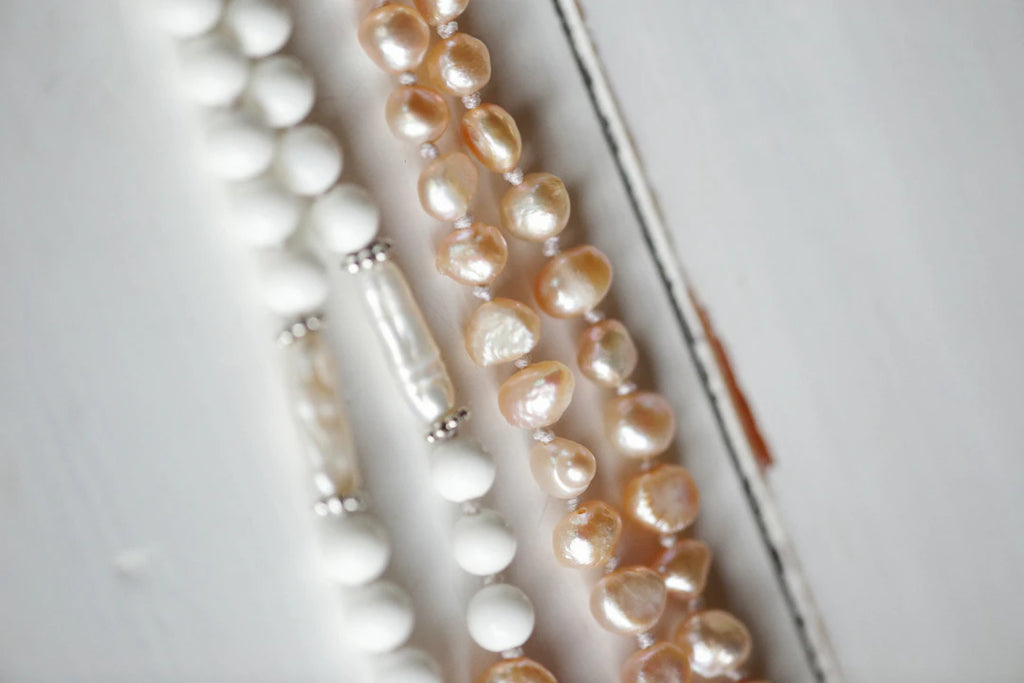Tahitian Pearls vs. Other Pearls: Unveiling the Differences

Overview
Explore the beauty and uniqueness of Tahitian pearls, known for their stunning colors and luxurious luster. Learn about pearl formation, differences between freshwater and saltwater pearls, and tips for selecting and maintaining your perfect pearl. Discover other types of pearls like Akoya and South Sea, and make an informed choice for your jewelry collection.
Frequently Asked Questions
1. What are Tahitian pearls known for?
2. How are pearls formed?
3. What is the difference between freshwater and saltwater pearls?
4. What factors should I consider when choosing a pearl?
5. How can I maintain my pearls?
Pearls have long been treasured for their beauty and elegance, making them a staple in the world of jewelry. Among the various types of pearls, Tahitian pearls stand out due to their unique qualities and the exotic origins from which they hail—French Polynesia. In this blog post, we will delve deep into the world of Tahitian pearls, comparing them with other types of pearls and highlighting what you need to know when choosing your next pearl investment. Whether you're a jewelry enthusiast or a first-time buyer, understanding the different kinds of pearls will help you make an informed decision.
The Basics of Pearl Formation
To appreciate the beauty of Tahitian pearls, it's essential to first understand how pearls are formed. Pearls are organic gemstones created within mollusks, specifically oysters. When an irritant—like a grain of sand—enters the oyster, the creature secretes layers of nacre around the object. Over time, these layers build up, resulting in a pearl. The type of oyster, the environment, and the nature of the irritant all influence the pearl's characteristics.
Freshwater vs. Saltwater Pearls
Pearls can generally be categorized into two types: freshwater and saltwater. Freshwater pearls are cultivated in rivers, lakes, and ponds, while saltwater pearls are formed in the ocean. Understanding the differences between these two types can help you navigate your pearl purchasing journey.
- Freshwater Pearls: Typically more affordable than saltwater varieties, these pearls are primarily produced in China. They come in a wide range of shapes, sizes, and colors.
- Saltwater Pearls: These are produced in the ocean and include famous varieties like Akoya, South Sea, and Tahitian pearls. Saltwater pearls are generally rounder and more lustrous than their freshwater counterparts.
What Makes Tahitian Pearls Unique?
Tahitian pearls, often referred to as "black pearls," are known for their stunning colors and luxurious luster. Sourced from the black-lipped oyster (Pinctada margaritifera) found around the lagoons of French Polynesia, these pearls possess an aura of mystery and allure that has captivated jewelry lovers worldwide. Here are some features that set Tahitian pearls apart:
Color and Luster
One of the most striking aspects of Tahitian pearls is their captivating color palette. Unlike traditional pearls that are typically white or pastel, Tahitian pearls come in a wide array of shades, including:
- Black
- Grey
- Green
- Pink
- Pewter
- Champagne
The luster of Tahitian pearls is another factor that makes them stand out. Their high luster gives them a beautiful glow, enhancing their visual appeal and making them a favorite choice for luxurious jewelry items.
Size and Shape
Tahitian pearls are larger than many other pearl varieties, typically ranging from 8mm to 18mm in diameter. Due to the farming conditions and the unique environment of French Polynesia, Tahitian pearls can exhibit an array of shapes, from perfectly round to baroque, adding to their unique character. The size and shape can significantly influence a pearl's value, making it essential to choose one that aligns with your personal style.
A Closer Look at Other Types of Pearls
While Tahitian pearls are remarkable in their own right, it's important to also consider other types of pearls available on the market for a broader perspective. Each type has its unique charm and characteristics.
Akoya Pearls
Akoya pearls are cultivated in Japan and are known for their classic look. They typically feature a round shape and a reflective surface, making them ideal for traditional pearl jewelry such as necklaces and earrings. The color palette for Akoya pearls ranges from white to cream, often with subtle rose or silver overtones.
South Sea Pearls
South Sea pearls are among the most luxurious types of pearls on the market. Harvested in the warm waters of Australia and the Philippines, these pearls are notable for their size and exquisite luster. The native Pinctada maxima oyster produces these pearls, which can vary in color from white to gold, giving you plenty of options for unique jewelry pieces.
Freshwater Pearls
As mentioned earlier, freshwater pearls are generally more affordable and are primarily cultivated in China. They often exhibit a beautiful array of natural colors, from pastel hues to vibrant shades. Unlike saltwater pearls, freshwater pearls come in various shapes, often varying from the classic round to unique baroque forms.
How to Choose the Right Pearl for You
When selecting a pearl, it’s essential to consider several factors that will help you find the perfect match for your style and budget. Below are some key attributes to keep in mind:
Color
Decide on the color that resonates with you. Tahitian pearls offer a beautiful spectrum of colors, while other pearls such as Akoya and South Sea primarily feature white, cream, and golden hues. Your choice of color can set the tone for your jewelry piece, so choose one that complements your skin tone and personal style.
Size
Size is another important factor to consider. Tahitian pearls are available in larger sizes, which makes them an impressive addition to any collection. However, consider the context in which you will wear them—smaller pearls can be more versatile for everyday wear, while larger pearls are often the centerpiece of formal jewelry.
Shape
While many people prefer perfectly round pearls, unique shapes like baroque Tahitian pearls can offer a distinct personality to your jewelry. Consider your style and the type of jewelry you wish to create when selecting the shape of your pearl.
Luster
Luster is one of the most important indicators of a pearl’s quality. The more reflective and shiny the surface, the more valuable the pearl. When assessing luster, examine the pearl in natural light to get a true sense of its brilliance.
Origin
Understanding the origin of the pearl can also add value to your purchase. Tahitian pearls, coming from French Polynesia, often carry a premium due to their geographic uniqueness. Knowing where your pearls come from can make a difference in both aesthetics and investment value.
Maintaining Your Pearls
Once you've selected your pearls, it's crucial to keep them in optimal condition to maintain their beauty and luster. Here are some maintenance tips:
- Store pearls separately to avoid scratches, ideally in a soft cloth or a dedicated jewelry box.
- Avoid exposing pearls to harsh chemicals, including perfumes and cleaning products.
- Clean pearls with a soft damp cloth after wearing to remove any oils or dirt.
- Wear your pearls often! The natural oils from your skin can help maintain their shine.
Final Thoughts: Discover Your Perfect Pearl
Understanding the differences between Tahitian pearls and other types of pearls can significantly enhance your purchasing experience. Whether it’s the vibrant colors of Tahitian pearls, the classic elegance of Akoya pearls, or the luxurious charm of South Sea pearls, each variety brings something special to the table. By being informed about the various factors that contribute to a pearl's beauty and value, you can make a choice that not only complements your style but also becomes a cherished addition to your jewelry collection—one that tells a story rooted in the enchanting waters of French Polynesia. Embrace the world of pearls, and find the piece that resonates with you today!

Laat een reactie achter